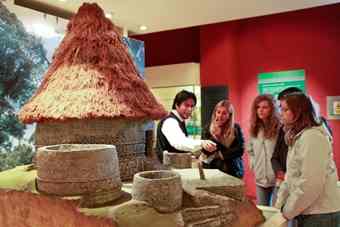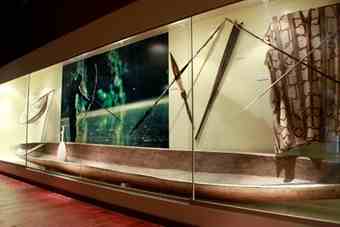Peru's National History Museum is set in a mansion built in the 18th century that used to be the home of illustrious personalities like José de San Martín and Simón Bolivar. It is known for having permanent exhibitions that chronicle art and artifacts from the first humans in Peru to contemporary times.
 The museum has just opened its doors to a region that was once considered distant and thus, forgotten: the Peruvian rainforest. The new permanent room is called Amazonía and frames a geography and a group of cultures, ideas and memories that are an active and fundamental part of the country’s sustainability.
The museum has just opened its doors to a region that was once considered distant and thus, forgotten: the Peruvian rainforest. The new permanent room is called Amazonía and frames a geography and a group of cultures, ideas and memories that are an active and fundamental part of the country’s sustainability.
A green obligation
This initiative was conceived by the museum’s administration when they noticed the Peruvian Amazon is largely forgotten in the construction of a national conscience. “We are talking about a national museum where every Peruvian’s history is found. Not having the presence of the people from the Amazon was really serious,” says Christian Mesía, archaeologist, anthropologist and manager of the museum. “I personally thought of this as an offense because the museum was denying these villages’ presence. That is why we have assumed this room as an obligation.”
 The exhibit has approximately 70 pieces belonging to groups including the Tutishcainyo, Chambira, Shakimu, Cumancaya, Kuélap, Gran Pajatén, Shipibo-Conibo, Aguaruna, Cacataibo, Machinguenga, and the Chachapoyas cultures. Archaeological objects such as vases, utensils, clothes, hunting weapons illustrate these cultures' history in Peru.
The exhibit has approximately 70 pieces belonging to groups including the Tutishcainyo, Chambira, Shakimu, Cumancaya, Kuélap, Gran Pajatén, Shipibo-Conibo, Aguaruna, Cacataibo, Machinguenga, and the Chachapoyas cultures. Archaeological objects such as vases, utensils, clothes, hunting weapons illustrate these cultures' history in Peru.
These objects were obtained thanks to excavations done by the archaeologists Donald Lathrap, Daniel Morales and Federico Kauffmann, who have donated the pieces that date from the beginnings of the settling process of Peru's Amazon 11,000 years ago. Modern pieces from the Museo de la Cultura Peruana and the Museo de la Nación have also been incorporated and they complete the exhibit. “It is a room that needs to be permanently revaluated and updated,” says Mesía, “the room is here to stay.”
Treasure to keep
 Among the treasures that the Amazonia room shows, there are hunting instruments, real size canoes, spears, models that show the houses’ construction according to the environment and a recreation of the mausoleum of the pinchudos, located in Pajatén. Visitors can be amazed at the heads reduced by the Jíbaros, feather crowns and art samples of the Chachapoyas culture, the petroglyphs of the Amazon plains and even the top part of a Karajía sarcophagus.
Among the treasures that the Amazonia room shows, there are hunting instruments, real size canoes, spears, models that show the houses’ construction according to the environment and a recreation of the mausoleum of the pinchudos, located in Pajatén. Visitors can be amazed at the heads reduced by the Jíbaros, feather crowns and art samples of the Chachapoyas culture, the petroglyphs of the Amazon plains and even the top part of a Karajía sarcophagus.
The idea is to keep and show this live world, loaded with symbolism, where wealth is not only in what can be exploited in the territory, but also in its great cultural memory, linguistic diversity, incredible animal and plant diversity and the populations’ ancestral wisdom that has endured modern times. This room fills a void in hour history and also exposes an important part of Peru.
Author: Diana Gonzales Obando | Source: Living in Peru [August 18, 2010]